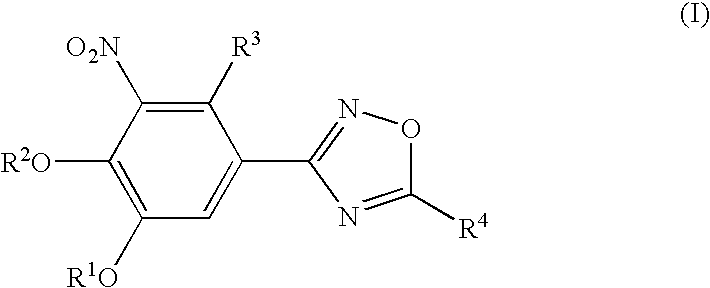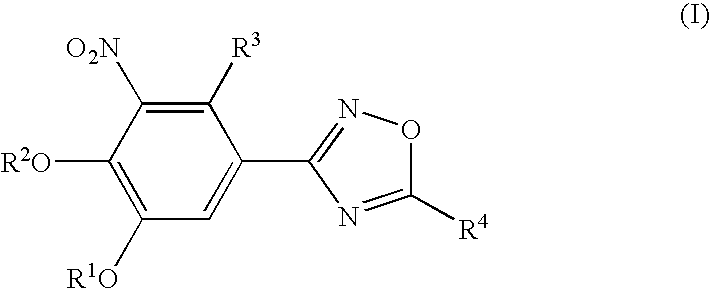Novel catechol derivative, pharmaceutical composition containing the same, use of the catechol derivative, and use of the pharmaceutical composition
a technology of catechol and derivative, which is applied in the field of new catechol derivatives, can solve the problems of severe liver function damage, entacapone has less potent efficacy than tolcapone, and the half-life of l-dopa and the amount of l-dopa crossing the blood-brain barrier, and achieves mild hepatotoxicity, good safety profile, and potent comt inhibitory activity.
- Summary
- Abstract
- Description
- Claims
- Application Information
AI Technical Summary
Benefits of technology
Problems solved by technology
Method used
Image
Examples
reference example 1-1
4-Benzyloxy-2-iodo-5-methoxybenzaldehyde
[0337]To a mixture of 4-benzyloxy-3-methoxybenzaldehyde (10 g), silver trifluoroacetate (11.4 g) and methylene chloride (105 mL) was added iodine (13.1 g) at room temperature. After stirring for 2 hours, the mixture was passed through a layer of Celite (registered mark). The filtrate was washed with an aqueous solution of sodium hydrogen sulfite and brine successively, dried over anhydrous magnesium sulfate, and concentrated under reduced pressure. The residue was triturated with methanol:water=4:1 to give the title compound (13.2 g).
[0338]1H-NMR (CDCl3) δ ppm:3.91 (3H, s), 5.19 (2H, s), 7.30-7.50 (7H, m), 9.86 (1H, s)
reference example 1-2
5-Benzyloxy-2-iodo-4-methoxybenzaldehyde
[0339]The title compound was prepared in a manner similar to those as described in Reference example 1-1 using 3-benzyloxy-4-methoxybenzaldehyde instead of 4-benzyloxy-3-methoxybenz-aldehyde.
[0340]1H-NMR (CDCl3) δ ppm:3.95(3H, s), 5.16 (2H, s), 7.29-7.47 (6H, m), 7.48 (1H, s), 9.84 (1H, s)
reference example 2-1
4-Benzyloxy-2-iodo-5-methoxybenzaldehyde oxime
[0341]A mixture of 4-benzyloxy-2-iodo-5-methoxybenzaldehyde (Reference example 1-1) (12.2 g), hydroxylamine hydrochloride (2.54 g), sodium acetate (6 g) and ethanol (170 mL) was stirred at 70° C. for 1.5 hours. The mixture was concentrated under reduced pressure. Water was added to the residue, and the mixture was stirred at room temperature for 30 minutes. The solid was collected by filtration to give the title compound (12.8 g).
[0342]1H-NMR (CDCl3) δ ppm:3.88(3H, s), 5.13(2H, s), 7.19(1H, s), 7.29(1H, s), 7.30-7.50 (6H, m), 8.30 (1H, s)
[0343]Reference examples 2-2 to 2-3 were prepared in a manner similar to those as described in Reference example 2-1 using the corresponding aldehydes instead of 4-benzyloxy-2-iodo-5-methoxybenzaldehyde. These were illustrated in table 1.
TABLE 1ReferenceexampleStructure2-12-22-3
[0344]The physical data of reference example 2-3 was shown below.
PUM
| Property | Measurement | Unit |
|---|---|---|
| temperature | aaaaa | aaaaa |
| temperature | aaaaa | aaaaa |
| temperature | aaaaa | aaaaa |
Abstract
Description
Claims
Application Information
 Login to View More
Login to View More - R&D
- Intellectual Property
- Life Sciences
- Materials
- Tech Scout
- Unparalleled Data Quality
- Higher Quality Content
- 60% Fewer Hallucinations
Browse by: Latest US Patents, China's latest patents, Technical Efficacy Thesaurus, Application Domain, Technology Topic, Popular Technical Reports.
© 2025 PatSnap. All rights reserved.Legal|Privacy policy|Modern Slavery Act Transparency Statement|Sitemap|About US| Contact US: help@patsnap.com



